Chasing The Milky Way
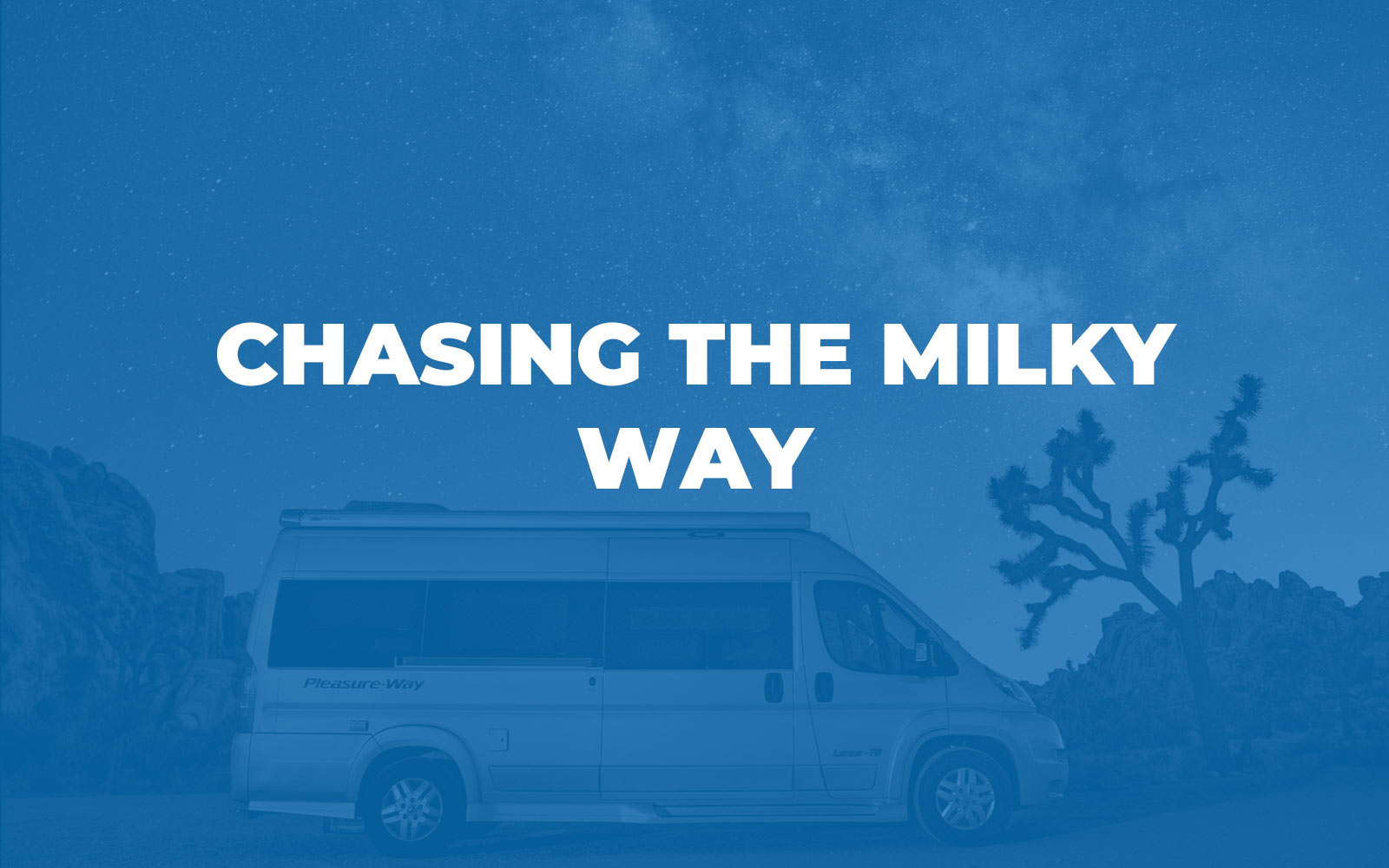
Written By: By Amethel Parel-Sewell
For a landscape photographer/astrophotographer, an RV is more than a recreational vehicle. While our Pleasure-Way Lexor, The Light Chaser (TLC), brings the joy, adventure, comfort, and conveniences expected from having an RV, it also provides strategic benefits for photography.
An awesome advantage is being able to spontaneously go to remote locations when the timing and unpredictable weather are right. When photographing landscapes with the night sky, the Moon, sunsets, or sunrises, being at the right place at the right time is critical. After we got The Light Chaser in 2021, we soon discovered it was also fun to photograph our campervan within the landscapes.
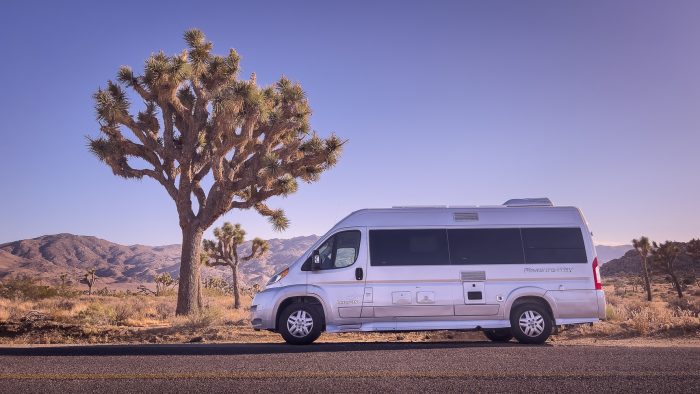
Before we had our RV, we stayed at hotels and spent lots of valuable time driving to remote locations with the dark skies needed for photographing the Milky Way. Now, our campervan lets us get closer to our destinations, minimizing time spent driving to and from a hotel. With our flexible mobility, we can easily change locations as needed. If dense clouds roll in and ruin the scene, we can simply drive to a new location with clearer skies, even many miles away. After a long night of shooting, we don’t need to drive to a hotel; we eat and rest in the safety and comfort of our home on wheels. When it’s time to wake up and photograph sunrise, we roll out of bed, make coffee, grab our gear and hop out to catch the first glimpses of morning light. It’s magical! As a photographer, there’s nothing better than being immersed in the natural environment you’re trying to capture.
One of my happiest places on Earth is being in The Light Chaser under the stars and out in nature. The mesmerizing beauty of the night sky and the quiet solitude sooth my mind, spirit, and body. When I tell my husband it’s time for some Nature Therapy, he knows it’s time for an adventure in the campervan. Ken is a wonderful co-pilot in our van adventures and we share a love of photography.
For this blog post, we’re going to focus on the basics of photographing the Milky Way, and specifically capturing your RV under the Milky Way. We love doing night photography in Joshua Tree National Park (JTNP) in Southern California, which is on the list of International Dark Sky locations. At JTNP, some campsites require advance reservations and some don’t. None of the RV campgrounds at JTNP have hook-ups. With our solar-powered batteries, a generator, full kitchen, convertible sofa bed, and bathroom, we’re highly self-sufficient and can easily dry camp for days. There are three first-come, first-served campgrounds and our favorite is Hidden Valley ($15/night). Of the five reservations-required campsites, our go-to is Jumbo Rocks ($20/night) with its sites nestled among giant boulders. There are also BLM campsites outside the park.
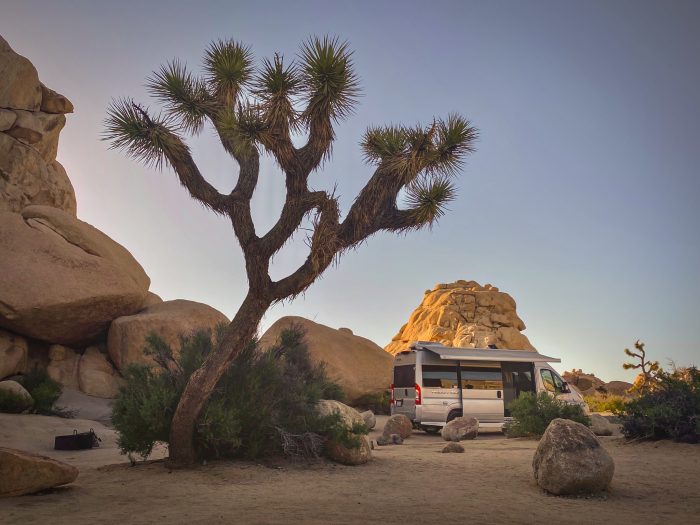
Hidden Valley is one of the first-come, first-served campgrounds at JTNP.
Finding the Milky Way
In the Northern Hemisphere, the best timeframe to see and photograph the Milky Way is from April to September when the galactic core will be most visible and bright. To photograph the Milky Way in April, you’ll have to shoot roughly between 1:00 AM to 5:00 AM, depending on your location. In May, you’ll shoot roughly between 11:00PM to 4:00 AM. In June and July, it’ll be roughly between 10:30 PM to 3:00 AM. If you’re not night owls like we are, you’ll prefer shooting during August to September, when the Milky Way is visible soon after dark.
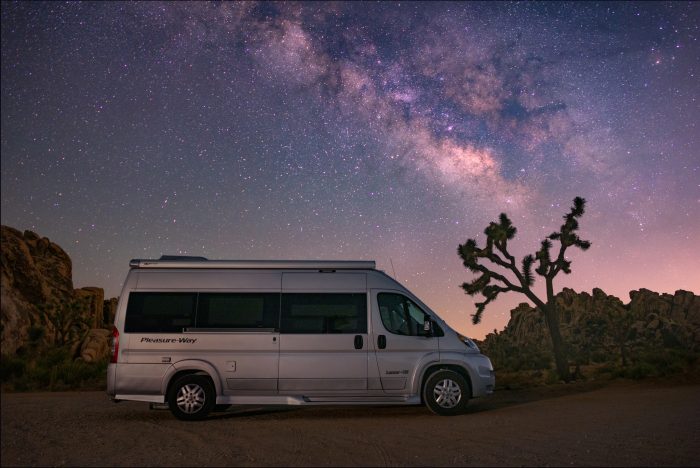
Chasing the Milky Way at Joshua Tree National Park (JTNP). The gear and settings
used for this image are: Canon R5, 24mm, f2.0, 20 seconds, ISO 2500
The Milky Way rises in the southeast, crosses the south, then sets in the southwest. Choose a viewing or camera location without major cities to the south because light pollution will wash out The Milky Way and its galactic core. Even if the sky directly above you is dark, the light pollution from a distant town to the south can wash out the core or ruin your shot entirely.
Strong moonlight also washes out the Milky Way. Choose a time during a new Moon or when the Moon has set, when the galactic core will be brightest. The best time to experiment may be during a crescent Moon; having a little moonlight (when it’s about 20-25% illuminated) can help light your foreground naturally with long camera exposures. There should also be little to no clouds in the sky where the Milky Way will appear.
As you can see, there are a lot of variables to consider when photographing the Milky Way. Don’t worry — there are some great tools for planning. If you’re just viewing the Milky Way, use one of the many astronomy apps like Sky Guide or Night Sky. To photograph it, you’ll need more advanced planning apps such as PlanIt Pro or PhotoPills, which will help you determine the best time and position of the Milky Way for your specific location.
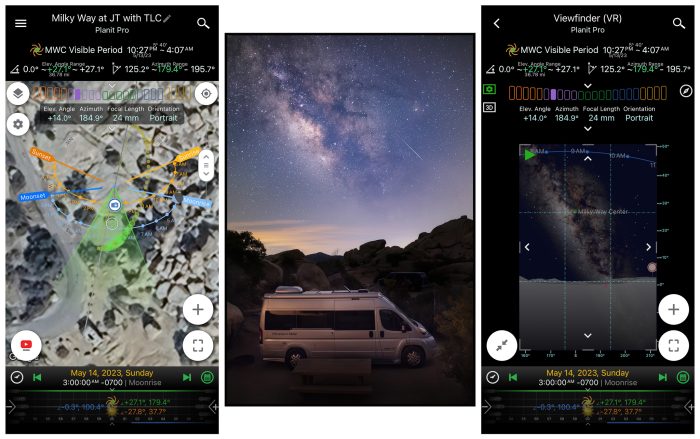
The left and right images are screenshots from the PlanIt Pro, the tool for planning landscape astrophotography scenes. At left is a map view of the camera location at JTNP. At right is a virtual view of the Milky Way rising from this location. In the middle is the final image shot with a Canon R5, 24mm, f2.0, 20 seconds, ISO 2500.
Another similar planning app is PhotoPills. It has an augmented reality feature that allows you to use your phone’s camera to overlay the Milky Way onto what you’re seeing in front of you. PhotoPills is a good way to quickly check the alignment of celestial bodies from your current location.
Photography Gear & Creating Your Composition
To photograph the Milky Way, you’ll need:
- DSLR or mirrorless camera with manual settings to adjust aperture (f-stop), shutter speed, and ISO
- Wide prime or fixed Lens (14mm to 24mm) with a wide aperture (ideally f2 or wider)
- Sturdy tripod to handle long camera exposures at night
- Remote shutter release to minimize camera shake during long exposures
- Large and/or extra memory cards for your camera
- Extra camera batteries, as long exposures drain your battery
- Optional: LED light with adjustable brightness and color temperature for low-level lighting.This can help create a dim light on the van during long night time exposures to make it pop.
If you’re new to Milky Way or night photography, it can be intimidating and frustrating to go out in the dark and set up a camera and tripod. Do this: before your shoot, practice mounting your camera on and off of your tripod, and adjusting your exposure and focusing in the dark. Learn to operate your tripod and camera settings by feel. Some photographers use headlamps or flashlights in the field, but these will cause your eyes to take longer to adjust to the dark and may disrupt other nearby photographers. If you need to use a headlamp or flashlight, briefly using a dim red-tinted light can help you see without impacting your night vision.
After deciding on your shooting location, arrive during the day time to make sure the view is clear of trees, buildings, or other obstructions. Find a scenic spot where you can creatively compose your photo with a good foreground for your RV. Set up your camera about 20-30 feet away from your van. Why? If you’re too close to your van, it won’t be sharp when you focus on the stars (more on this later).
A strong photo shows a sense of place, tells a story, and conveys a mood or feeling. It has creative, clean composition and the focal point or main area of interest is sharp. It’s also well-exposed, has good color balance, and nice details.
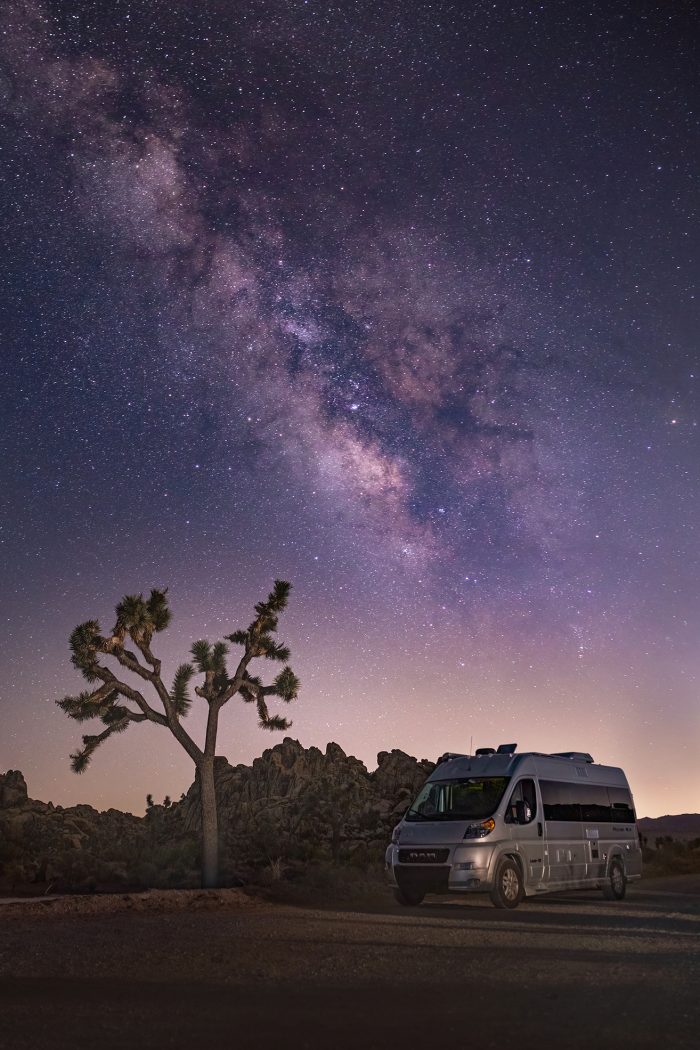
In Joshua Tree, you could position your van near a Joshua Tree or some giant boulders. Make sure the area is accessible at the time you need to be there. Check to make sure there’s no light pollution around your van or in the distance. Whatever location you use, be mindful about restricted areas for parking and hiking. Watch for potential dangers including heat advisories. At JTNP, the temperatures can be over 100 degrees! When hiking or climbing rocks, look before you place your hands or feet. Avoid stepping or reaching into places you cannot see to avoid snakes, spiders, and scorpions. And last, but not least, be a good steward of Mother Nature and explore how to “Leave No Trace” when enjoying the outdoors.
Back to the Milky Way: it’ll be visible to the naked eye, but it’ll be faint. The long camera exposures will capture more light than you can see with your eyes. Take a few test shots with your camera to make sure your van and Milky Way are in the correct position in your composition. Check your exposure settings and make sure the stars are in focus. To check your focus, use your camera’s live view tool; zoom in and focus manually on the brightest stars. If your camera has a focus peaking tool that shows when an area is in focus, use it. It may help to set your focus to infinity, then work backwards to dial in your exact focus. Here’s a good range to start with your camera’s exposure in a dark sky area; you will have to adjust based on the conditions and ambient light:
- Shutter speed: 15-20 secs
- Aperture: f2–f2.8
- ISO: 2000-3200 ISO
To narrow it down even more, in astrophotography, there’s a “500 Rule” for determining exposure times to get sharp stars without trails on full frame (vs. crop sensor) cameras. Take 500 and divide it by your lens focal length to get your exposure time. For example, a 24 mm lens (my favorite lens for landscape astrophotography) has an ideal exposure of 20 seconds. For my set-up, which is a Canon R5 with a 24mm f 1.2 lens, my usual exposures are f2, 20 secs, at ISO 2500.
If the foreground with your van is too dark, use your phone or an LED light at a low setting to briefly shine light onto your van for a few seconds; this is known as light painting. Have fun (and patience) experimenting with your composition, exposure, and light painting techniques.
After you download your images, the Milky Way will be visible in your image, but you’ll still need to make some enhancements in your photo editing software to bring out its color and detail. If you use Adobe Lightroom or Photoshop, use a mask to add moderate amounts of dehaze, clarity, contrast, and denoise to make the Milky Way pop. Be careful not to overdo it with the processing of the image.
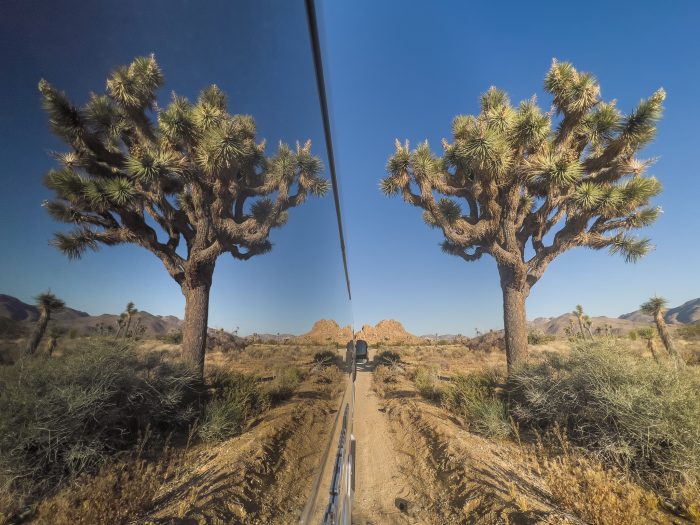
If you’re up for the challenge, you can dive into more advanced techniques such as blue hour exposure blending, where you shoot your foreground during blue hour, then wait to shoot the Milky Way when it rises. These images are then stacked and blended in Photoshop. Another technique is using a motorized device called a star tracker that allows your camera to move with the Earth’s rotation to follow the stars and capture even greater detail.
Most importantly, with or without a camera, just immerse yourself in the celestial wonders of the night sky. At some point, just clear your mind, take a deep breath, and savour the moment. Happy travels to you from sunrise to the Milky Way!

